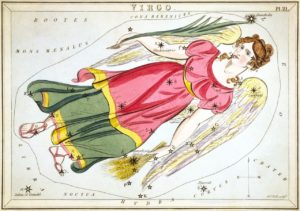The sun has already entered Virgo, and loyal (but kinda late) as I am to this section, I’ve been researching the myths surrounding it for quite some time now. One would think that such research shouldn’t take so much time, but trust me, this is one complicated constellation. Daring an astrology joke, this constellation is far more complicated than it would want to be.
Let’s start with the basics, and by that I always mean etymology! The word “virgin” is of course Latin, and although in our collective minds, it means a person who never had sexual relations, the original meaning is closer to someone being pure and “untouched”. Think about it. When you buy “virgin olive oil”, it doesn’t mean that your oil never made whoopie, it means that the olives used where “young” and pure.
As with most constellations, this one has always been a woman symbolizing fertility/harvest. From Babylon and the goddess Shala at first and Ishtar later, to the Middle Ages and the Virgin Mary, this sign has always depicted the same thing. A pure, young woman, holding an ear of grain on one hand, and according to each myth, a palm-frond, or scales, on the other.
When we reach ancient Greece and dive in its mythology, is when things are getting really complicated. Apparently there are at least five different Greek approaches to this myth, and I can only assume, that like the Babylonians, the myths were changing according to the time and beliefs.
So, the first Greek myth associates Virgo with Demeter, the goddess of agriculture. Later on, Virgo is associated with her daughter, Persephone. I guess you know all about how Pluto, the god of the Underworld, fell in love with her and kidnapped her to his realm, Hades. She was allowed to visit Earth from roughly March until roughly August and coincidentally, this is the time frame when the constellation is visible. Makes sense.
According to other sources, Virgo depicts the winged goddess Dike, which literally means “Justice”. Dike was one of the three Hores (Hours). Her sisters were Eunomia (Goodwill comes close) and Irini (Peace). I think that I don’t need to elaborate more on what they stood for; the names speak for themselves. According to one myth, Dike got angry when people stopped honoring the Gods, and after giving them a fiery speech, she abandoned them and fled to the heavens. She is depicted holding the justice scales. On a similar note, we have the myth of Astraea, who also symbolizes justice, and is holding the scales. Astraea’s story is very similar to the one of Dike, in fact they are almost identical. I can only assume it’s a time/location issue.
Last but not least, the story of Erigone. She was the daughter of Icarius (not to be confused with Icarus). Father and daughter were devotees of Dionysus and they had gained his favor. Icarius was murdered by his shepherds after a Dionysian orgy, and torn by grief, Erigone hanged herself. Dionysus honored them by turning them into Virgo and Bootes.
See? I told you it was complicated…
For those of you following the constellation myths segment, take note! You’ll need info from this text for Libra!

First published: 29/8/2017
